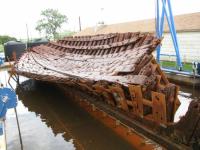 Two years ago we posted about how a team of scientists at the Texas A&M University Center for Maritime Archaeology and Conservation were using freeze-drying to preserve large sections of French explorer’s Robert LaSalle’s flagship, La Belle, which sank in Matagorda Bay in 1686. Now, the preserved sections of the ship are being moved from their labs in Bryan, TX to the Bullock Texas State History Museum, in Austin, TX.
Two years ago we posted about how a team of scientists at the Texas A&M University Center for Maritime Archaeology and Conservation were using freeze-drying to preserve large sections of French explorer’s Robert LaSalle’s flagship, La Belle, which sank in Matagorda Bay in 1686. Now, the preserved sections of the ship are being moved from their labs in Bryan, TX to the Bullock Texas State History Museum, in Austin, TX.
In 1995, archaeologists discovered the wreckage of La Belle. The lower portion of the hull had been preserved from decay by being covered in mud. Excavating the hull risked immediate damage once the waterlogged timbers were exposed to the air. The team at Texas A& M used the biggest freeze-drying machine on the continent devoted to archaeology to prevent the three hundred year old wood from shrinking and cracking.
When the Swedish warship Vasa was raised from the seabed in 1961, to prevent her her waterlogged timbers from shrinking and cracking, the hull was sprayed, inside and out, continuously with polyethylene glycol for 17 years, followed by 9 years of slow drying. By freeze-drying the wreckage of La Belle, the Texas A&M team succeeded in stabilizing the wood in only two years.
Shipwreck From 17th Century on Final Journey
Archaeologists from the Texas Historical Commission discovered the shipwreck in 1995, located in 12 feet of muddy water. They built a dam around the wreckage and pumped the water out until it was dry. The researchers dug through nearly six feet of mud to recover around 700,000 items, including the nearly intact hull. They also found a slew of guns, swords, and ammunition, as well as three cases of rifles, and a cannon.
The archaeologists working on the shipwreck also discovered a skeleton which is believed to be the remains of a settler or a crew member. The mud that encased the hull prevented its corrosion from salt water or worms and bacteria. In most cases, wood will outlast iron if it is covered.
The 17th-century shipwreck made the first stop in its final journey in the summer of 2012 when it was hauled to the Texas A&M lab. Once there, the European oak wood was kept at 60 degrees below zero in the biggest archaeological freeze dryer on Earth so that it could keep the wood solid by removing 300 years of moisture. Originally, 400 pieces of wood were marked at the site. However, due to breakage during the recovery, that number became 600.
On Thursday, the challenge was to protect the fragile pieces with foam and wood frames, then lay them on an aluminum platform and limit any flexing or abrasion during the ride to Austin. Eventually, what remains of the ship will be pieced back together. The reconstruction is set to begin in the fall and should be completed by May of next year.
Thanks to Irwin Bryan for contributing to this post.

Once again modern science and technology proves its ability to produce amazing results. However, despite my approval of such fears of historic preservation, it sometimes leaves me wary of the fact that so much time, effort and money will go into saving long-sunken ships, yet we constantly lose existing, afloat, historic vessels due to a lack of the same factors.
Pingback: Wrak VS vriesdroog naar museum | Bootjesgek.nl
So its now like freeze dried coffee and will crumble at any touch, shake or jar.
I’m kidding.